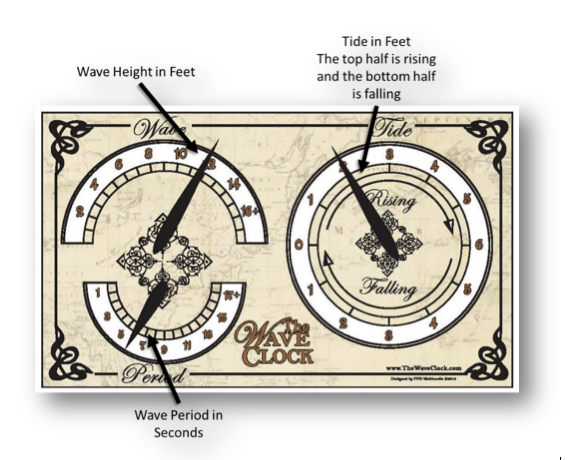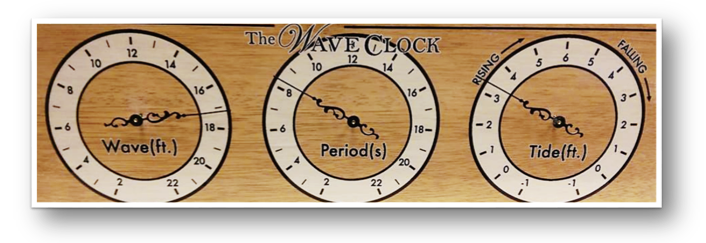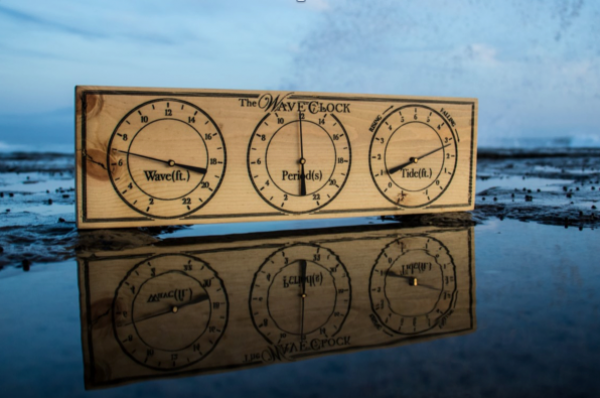Companies
WaveClock: Viewing the Ocean as Never Before
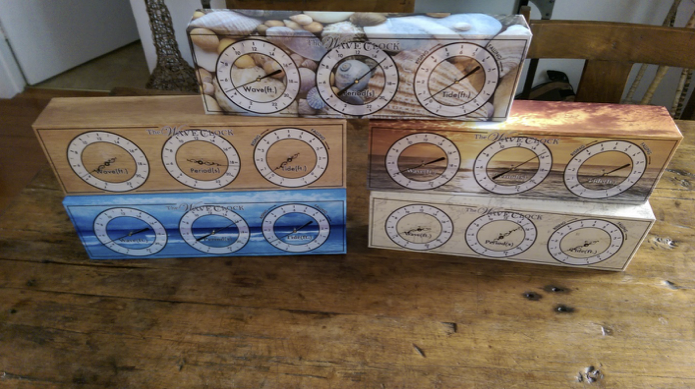
By Craig Jones, President/Inventor and Ocean Pooh-bah
The WaveClock
Special to Santa Cruz Tech Beat
July 16, 2015 — Santa Cruz, CA
We have forgotten that the basic analog display of information not only gives us a more attractive display, but a more intuitive one as well.
The Waveclock queries real-time oceanographic databases to find the wave and tide information, and displays it in an intuitive analog interface.
A hot cup of coffee on East Cliff to watch the sunrise is always a peaceful time. Looking out over the rolling waves with only their crashing sound to break the silence. The surfer in me watches each set and draws imaginary lines up and down the face of the wave. The scientist in me wonders where this swell was generated and how many thousands of miles it traveled to Monterey Bay. Is it coming from the North or South? Is it coupled with wind or was it generated in the South Pacific with an ocean of water to travel? These morning ponderings are easily answered with a visit to the NOAA website to look the latest data and models or any number of surf forecast sites. But the link to a digital screen has a cold impersonal feel to what I see out here.
In simple terms it’s a weather station for the waves and tides.
The WaveClock is, in simple terms, a weather station for the waves and tides. It is a personal ocean gateway designed to show the ocean information at a user’s favorite spot on the coast at a glance. The WaveClock queries real-time oceanographic databases to find the wave and tide information. The information is then displayed instantly on a natural analog display, doing away with the need for digital searching on endless websites. The WaveClock gives you an accurate view of what’s happening out there right now via real-time updates. The display is simple and intuitive to read (see figures below) with dials that show wave height in feet, the wave period in seconds, and the rising or falling tide height at your selected location.
The WaveClock displays:
- Wave heights and period
- Tide heights and trend
- Constant updates for your favorite locations throughout the USA
- Intuitive analog interface
The WaveClock uses an Electric Imp (www.electricimp.com) microcontroller to connect to the internet and link to a smartphone app used for programming. The Electric Imp’s BlinkUp process is used in order to program the hardware clock to Wifi, download software, and register with Electric Imp’s server. The processes essentially blinks to program an optical sensor on the clock with your WiFi information. This uniquely, and ingeniously, links your Waveclock and your app. The WaveClock downloads the information from the appropriate NOAA websites and displays them on the hardware. The flowchart below generally shows how all this links up and where the information comes from.
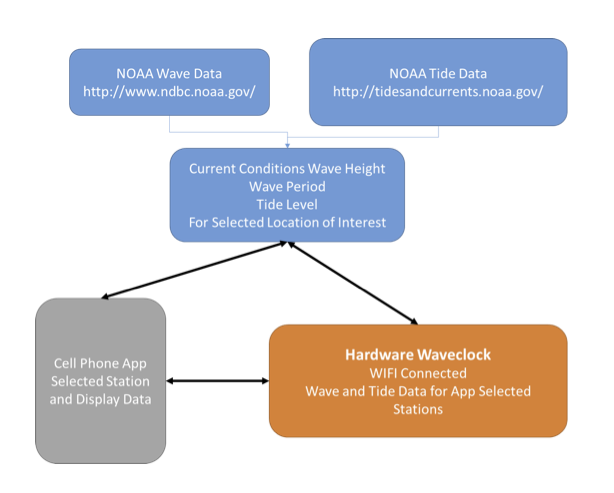
The flowchart above shows how WaveClock information links up and where the information comes from. Image contributed.
The WaveClock app for iPhone, iPad, and Android Devices is available for download on the Google Play and iTunes stores. While in itself a digital display, the app gives the full functionality of an analog WaveClock with graphics to give a flavor of the hardware. The app can dial into any NOAA wave buoy and tide station worldwide. Importantly, this is the gateway to program the hardware. The WaveClock hardware, designed to sit on a desktop or hang on a wall, is available in horizontal and vertical configurations with a wide variety of artwork.
Pleasure Point roots
The WaveClock technology began in Pleasure Point, Santa Cruz as a side project on my (Dr. Craig Jones) dining room table. The inspiration came from no only morning coffee at the point, by my career in working with oceanographic instrumentation to study ocean environmental problems. After learning the ins and outs of motors, controllers, and WiFi, I enlisted the help of my neighbor Jeff Bettencourt (owner of Pleasure Point Design) and George Tate (incredible local woodworker) to build the beautiful clock you now see on display at the East Side Eatery in Pleasure Point, Santa Cruz. This led to further living room table testing adventures until a solid design emerged.
My philosophy has always been simplicity. With the incredible advances in modern day technology and data displays, we have forgotten that the basic analog display of information not only gives us a more attractive display, but a more intuitive one as well. The WaveClock components are manufactured in the USA and assembled in Pleasure Point, Santa Cruz.
WaveClocks are now available for sale through www.thewaveclock.com.

“The basic analog display of information not only gives us a more attractive display, but a more intuitive one as well.” Photo contributed.
###
If you wish to republish this article, please follow these guidelines:
- Add “The following article by <name of author> was originally published in Santa Cruz Tech Beat” at the top of your copy of SCTB’s article and link that text to the original article in SCTB.
- If you follow the above guideline (#1), you are welcome to publish a couple paragraphs of teaser text and then “Continue reading in Santa Cruz Tech Beat.” and link that text to the original article in SCTB.
Learn more about our guidelines here.
Tagged WaveClock





